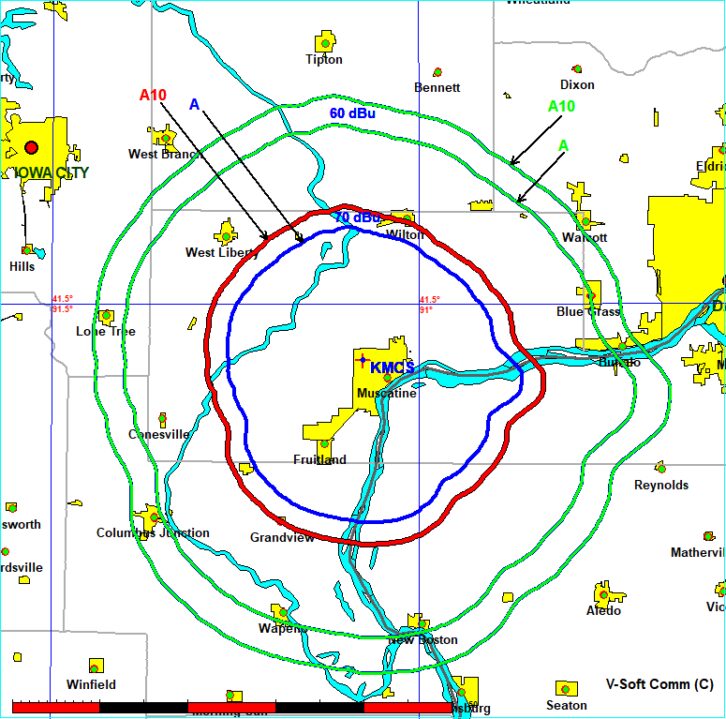The author is president of V-Soft Communications.
The FCC is taking comments until July 22 on whether it should establish an FM station class called A10. Mississippi broadcaster Carl Haynes believes this would allow hundreds of FM Class A stations to increase power, and that it would be easier than under the previously proposed Class C4. By reducing the required minimum distance separations, the proposal opens the ability for more stations to qualify.
Of course, the Haynes petition still requires FCC approval. Under the proposal, Class A stations interested in the increase would have to meet the new co-channel and adjacent-channel class A10 distance separations. The transmission tower location would have to be fully allocated by meeting the distance separation rules (see Section 73.207) and by serving the entire principal city with the minimum 70 dBu signal strength.
To facilitate this analysis, V-Soft Communications has added the proposed A10 digital separation tables as shown in the accompanying table to its FMCommander allocation program. The addition of this computerized table enables a user to minimize the effort to determine if a station could become a Class A10. (Maps shown in this article were made using the V-Soft program.)
Several years ago, if an FM station wanted to change its class, the licensee would have to petition the FCC to amend the city-by-city allocation assignments in the rules to include the new class. This process was always backlogged thanks in part to delaying counterproposals from other stations. The FCC has since dropped the petition requirement, streamlining it with what they call “the one-step,” an easier process that nevertheless involves more than one step.
The map in Fig. 1 shows an example of a hypothetical “area-to-locate” for proposing a 10 kW, Class A10 assignment. The green circles are the separation distance circles for the proposed A10 class as drawn from the minimum distance table shown in the table.

The location where the station could place its tower is very small, confined to an area not reached by any of the green minimum separation circles. The pink circle is the 70 dBu allocation area that must include the principal city’s boundary within it. The actual allocation site of this example is about 9 kilometers from the currently licensed site for this station.

Real examples are relatively easy to find from the FCC database of Class A stations, and this fact helps to confirm the argument that many FM station owners may benefit from the petition to change the rules to create the new 10 kW class of FM stations.
Assuming an antenna height of 100 meters, the proposed Class A10 would have a maximum power greater than the Class A 6 kW and equal to or less than 10 kW.
See Fig. 3 for a comparative coverage map of a maximum power Class A10 and the maximum Class A.

Steps
If a station wanted to upgrade to the proposed Class A10, here’s what it would have to do:
- Have a suitable spot on the FM dial — The station would have to identify that its frequency allows it to meet all the new A10 distance separations for co-channel and adjacent-channel interference. (While it is possible for a station to change its frequency, this is not allowed when proposing the “one-step” procedure.)
- Existing tower location — If the station were able satisfy all A10 separation requirements from its current tower location, the process would be straightforward and not require identifying a separate tower location; however, based on the crowded FM spectrum that would be highly unlikely.
- New tower location — If the existing tower site failed to meet the A10 separations, the station might be able to qualify for a “one-step” site where the all the distance separations were met, and the principal city were properly served by the city-grade contour. Unless the station really wanted to move its transmitter location to this allocation site, it might make an application to the FCC to keep its currently licensed tower site under 73.215 short-space rules. This strategy would save the costs of establishing a new tower site. If a fully allocated A10 transmission site could not be found that meets all the requirements, the station would have to stay as Class A.
Key points
Assuming the FCC were to adopt the new class, here are the key points for an applicant developing an A10 FCC application while using the one-step process:
- A10 separation requirements: The station would have to identify a fully allocated Class A10 site. The tower site could be at a different location than the licensed site, however the location would have to meet all the co-channel and adjacent-channel distance separations.
- Principal city service: The station would have to maintain the minimum signal strength required under the rules to serve the principal city at the identified A10 site.
- Directional antennas and power reduction: If the station proves it has identified a tower site that meets the A10 minimum distance separations and properly serves the principal city but is somewhere other than the currently licensed site, and if it desires to keep its existing tower location, it could use a directional antenna or reduce power using the short-space rules to prevent interference. The Hayne’s petition also proposed a second set of tables that define the maximum short-space distances allowed for the new class in its frequency and distance relationships with other classes of stations.
- Cost-effective strategy: By allowing the station to initially allocate a compliant location on paper and later move back to the original site, the one-step process minimizes the need for costly new tower construction.
This approach offers flexibility and cost savings for stations seeking to increase power while ensuring compliance with the latest FCC regulations.
Comments about the A10 proposal can be filed via the FCC online filing system. Cite MB Docket No. 24-183. Comments are due July 22, with replies due Aug. 21.







